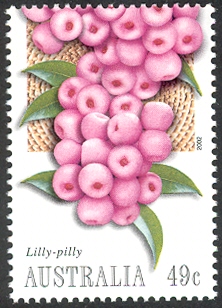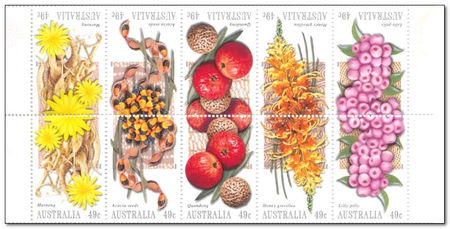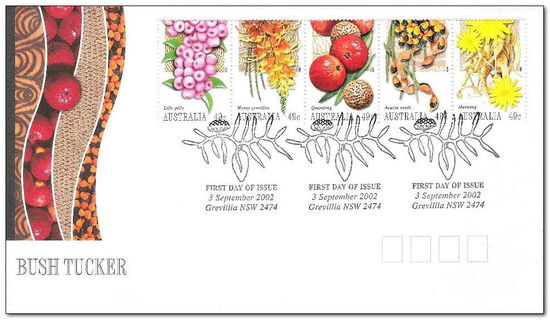Australia 2002 Bush Tucker
- Issue Date : 3rd September 2002
- Gum : (a) Ordinary Gum, (b) Self Adhesive (Stamps issued in both formats)
- Designed by : Janet Boschen
- Printed by : (a) McPhersons, (b) SNP Ausprint
- Print Process : Lithography
- Perforations : (a) 14.5 x 14 (b) 11.5
- Stamp Size : 26mm wide x 37.5mm deep
- Paper : (a) Phosphorised (b) Phosphor background
Contents
Description
No matter how you look at it, this issue is both beautiful and fascinating. The subject is Bush Tucker and features five Australian plants traditionally eaten by Aboriginal people. The part of the plant consumed (and depicted) varies from the tuber (murnong); fruit (quandong and lilly-pilly); seed (acacia); and flower (honey grevillea). The featured plants are found in a range of climates and locations throughout Australia.
The plant foods are shown against a background of a woven basket or wooden coolamon. These containers, from the collections of the Museum of Victoria, are appropriate to particular regions where the foods are found.
The stamps was printed in sheets of 50, in two panes of 25, with a decorative gutter. The design takes advantage of the tête-bêche printing format, using it to enhance the impact of the designs. The design bleeds into the selvedge at the top and bottom of the sheet. The gutter design bleeds into the selvedge of the adjacent stamps.
The bush banana motif which runs through the gutter is directional. The bananas hang ‘down’ thus defining the sheet’s top and bottom. The individual stamps and the design set itself make their visual statements when viewed in isolation. As well they can be visually combined with their tête-bêche ‘partners’ to create additional views.
Stamps
Sheet Stamps
Single Stamps
49c Lilly-Pilly Stamp
There are several varieties of lilly-pilly fruits that may be eaten. Acmena smithii, depicted on the stamp, grows best in the moist soil of mountain gullies from Victoria to Northern Queensland. The pale mauve or white berry-like fruits are pleasantly tart and juicy and can be picked and eaten raw from the tree. Acmena smithii is a common urban street tree.
The basket in the background was made from plant fibre by Joyce Moate of Healesville, Victoria. The coil technique is typical of the weaving traditions of South-Eastern Australia.
49c Honey Grevillea Stamp
Grevillea juncifolia grows on sand plains and dunes in Central Australia. It is characterised by large orange flower clusters with abundant nectar. The sweet honey is highly sought after and can be sucked directly from the flower or extracted by steeping the flower in water to make a sweet drink.
The wooden coolamon in the background was made by Tjuliata of Ernabella, Central Australia. The burnt poker work designs represent women dancing.
49c Quandong Stamp
The quandong (Santalum acuminatum) is a traditional staple food with a vitamin C content twice as high as that of an orange. Quondong trees are found in semi-arid areas of all mainland states. The small bright red fruits are eaten raw. Dried fruit, collected from under the tree, can be reconstituted in water. The fruit can also be pounded and made into cakes to be dried and stored for later use. The relatively large kernels can also be eaten or ground into a paste for medicinal purposes.
The plant-fibre string bag used for the background was made in a figure eight stitch in Victoria.
49c Acacia Stamp
The seeds of many types of acacia trees are eaten by Aboriginal people throughout Australia. One of the more attractive varieties, Acacia coriacea, is characterised by long, twisted pods containing vivid orange and black seeds. This acacia, also called dogwood, grows on the spinifex sandplains of Central Australia. When they are green, the pods are roasted and the seeds extracted and eaten. Hardened seeds are also picked off the ground then soaked and mashed with water to make a ‘milky’ drink.
The coolamon in the background, made at Tennant Creek, Northern Territory, is decorated with red ochre and white dots.
49c Murnong Stamp
The murnong (Microseris ‘lanceolata’) is a small root vegetable resembling a dandelion. Murnong was a staple food of Aboriginal people in South-Eastern Australia until the mid 19th century when introduced grazing animals rapidly destroyed this once abundant and widespread plant. Now the murnong is considered an endangered species. Murnong tubers were sometimes eaten raw but were usually cooked in baskets.
The plant-fibre woven bag in the background was made in a figure eight stitch in Victoria.
Se-tenant Strips
Tete-Beche Block
Gutter Strips
Self-adhesive Stamps
Single Stamps
Booklet
$4.90, booklet containing pane of 10 stamps - 2 x each of the above self adhesive stamps.
First Day Cover
The first day of issue postmark was Grevillia, NSW 2474. First day covers were produced with se-tenant strip version "A" only.
Maximum Cards
Presentation Pack
Only the "B" version of the se-tenant strip was included in the presentation pack.


























